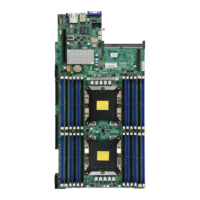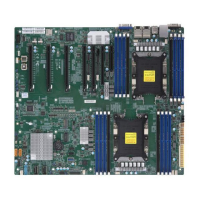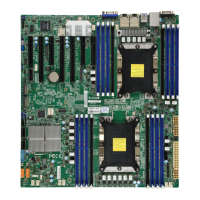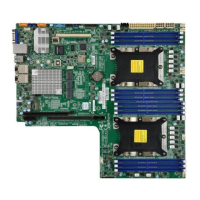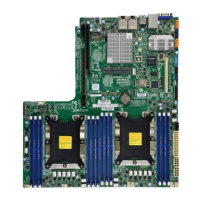13
Chapter 1: Introduction
Quick Reference Table
Jumper Description Default Setting
JBT1 CMOS Clear Open (Normal)
JPME2 ME Manufacturing Mode Pins 1-2 (Normal)
JPTG1 Onboard 10Gb LAN1/LAN2 Enable/Disable Pins 1-2 (Enabled)
JWD1 Watch Dog Timer Reset Pins 1-2 (Reset)
Connector Description
BT1 Onboard Battery
COM1 COM Port (COM1) on the I/O Back Panel
COM2 COM Header
FAN1 ~ FAN6, FANA,
FANB, FANC, FAND
System/CPU Fan Headers (FAN5: CPU1 Fan, FAN6: CPU2 Fan)
I-SATA0~3, I-SATA4~7 Intel PCH SATA 3.0 Ports (0~3, 4~7)
IPMI_LAN Dedicated IPMI LAN Port
JF1 Front Control Panel Header
JIPMB1 4-pin BMC External I
2
C Header (for an IPMI card)
JL1
Chassis Intrusion Header (Note: Please connect a cable from the Chassis Intrusion header at JL1
to the chassis to receive an alert via IPMI.)
JNCSI1 NC-SI Header for IPMI Support
JNVI2C1
NVMe SMBus (I
2
C) headers used for PCIe hot-plug SMBus clock & data connections, and for
the NVMe Add-on Card on PCIe Slot9 (an SMCI-proprietary NVMe add-on card and cable are
required; available for a Supermicro complete system only)
JNVI2C2
NVMe SMBus (I
2
C) headers used for PCIe hot-plug SMBus clock & data connections, and for
the NVMe Add-on Card on PCIe Slot10 (an SMCI-proprietary NVMe add-on card and cable are
required; available for a Supermicro complete system only)
JPI2C1 Power Supply SMBus I
2
C Header
JPWR1 24-pin ATX Power Connector
JPWR2, JPWR3 12V 8-pin CPU Power Connectors
JPWR4 12V 4-pin Power Connector
JRK1 (VROC) Intel VROC RAID Key Header for NVMe SSD
JSD1, JSD2 SATA DOM Power Connectors 1/2
JSEN1 Inlet Sensor Header
JSTBY1 Standby Power Connector
JTPM1 Trusted Platform Module/Port 80 connector
JUIDB1 UID (Unit Identier) Switch
Note 1: Intel VMD is supported by CPU2 SLOT9 and CPU2 SLOT10.
Note 2: After you’ve enabled VMD in the BIOS on a PCIe slot of your choice, this PCIe
slot will be dedicated for VMD use only, and it will no longer support any PCIe device.
To re-activate this slot for PCIe use, please disable VMD in the BIOS.

